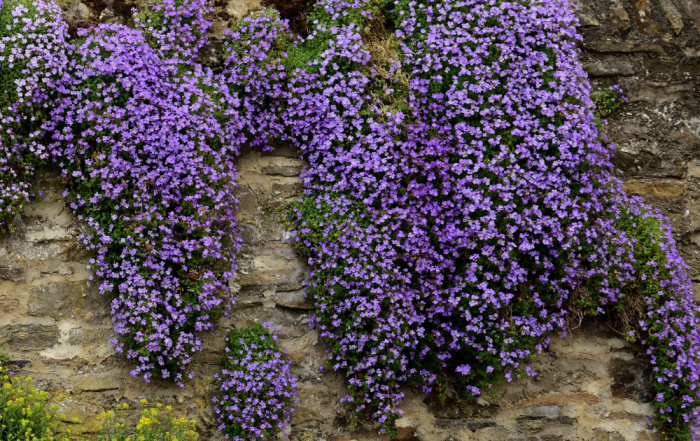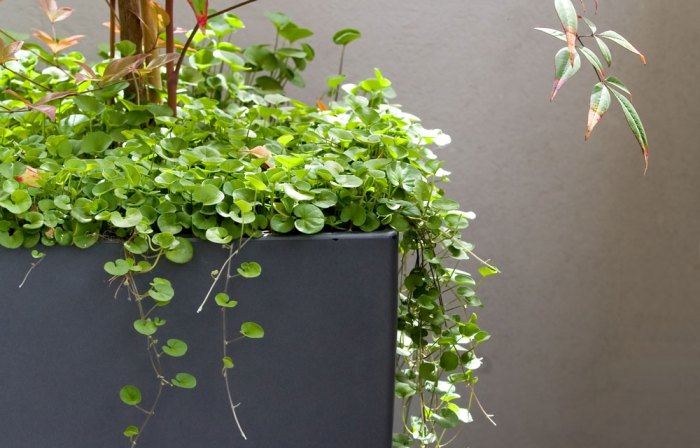Bunnings cascading plants are a captivating addition to any garden, offering a cascade of vibrant foliage and blooms that can transform vertical spaces and create stunning focal points. This comprehensive guide will delve into the world of cascading plants, providing you with expert tips on selecting, planting, and caring for these enchanting specimens.
From choosing the right species for your specific garden conditions to mastering the art of regular maintenance, this guide will empower you to create a thriving and visually stunning display of cascading plants.
Plant Varieties and Characteristics

Bunnings offers a wide selection of cascading plants, each with its unique characteristics and growth habits. These plants are ideal for adding a touch of greenery and color to gardens, balconies, and indoor spaces.
Bunnings offers a wide variety of cascading plants, perfect for adding a touch of greenery to your home. For more inspiration on hanging plants, check out Hanging Plants for Indoor Decor: A Guide to Greenery from Above . Bunnings cascading plants are available in a range of sizes and colors, so you’re sure to find the perfect one for your space.
Cascading plants can be categorized into three main types: vines, trailers, and groundcovers. Vines are climbing plants that require support to grow upwards, while trailers spread horizontally along the ground or over surfaces. Groundcovers are low-growing plants that form a dense mat, helping to suppress weeds and retain soil moisture.
Popular Cascading Plant Species
- Trailing petunia (Petunia × hybrida) : A popular annual with trailing stems that produce a profusion of trumpet-shaped flowers in various colors.
- Ivy geranium (Pelargonium peltatum) : A perennial with trailing stems and glossy, lobed leaves. It produces clusters of small, trumpet-shaped flowers in shades of pink, red, and white.
- Trailing lobelia (Lobelia erinus) : A compact annual with trailing stems and small, star-shaped flowers in shades of blue, purple, and white.
- Creeping Jenny (Lysimachia nummularia) : A vigorous groundcover with trailing stems and small, round leaves. It forms a dense mat that can quickly cover large areas.
- Vinca minor (Vinca minor) : A perennial groundcover with trailing stems and glossy, evergreen leaves. It produces small, blue flowers in the spring.
Choosing the Right Cascading Plant
When choosing a cascading plant, it is important to consider the specific conditions of your garden, such as sun exposure, soil type, and space availability. Vines are best suited for areas with vertical structures, such as trellises or arbors, while trailers can be grown in hanging baskets, window boxes, or along the edges of raised beds.
Groundcovers are ideal for covering large areas, such as slopes or under trees.
It is also important to consider the foliage characteristics of the plant. Some cascading plants have attractive variegated leaves, while others have fragrant flowers. By carefully selecting the right cascading plant, you can create a beautiful and functional addition to your garden.
Planting and Care Guide

Planting and caring for cascading plants requires proper techniques and regular maintenance to ensure their health and attractiveness. Here’s a detailed guide to help you cultivate thriving cascading plants.
Soil Preparation and Planting
Cascading plants prefer well-drained, fertile soil. Amend the soil with organic matter such as compost or peat moss to improve drainage and nutrient content. Dig a hole twice the width of the root ball and deep enough to accommodate the roots.
Gently remove the plant from its container and place it in the hole. Fill in the soil around the roots and tamp down gently to remove air pockets.
Watering
Water cascading plants deeply and regularly, especially during hot and dry weather. Allow the soil to dry out slightly between waterings. Overwatering can lead to root rot, so it’s crucial to avoid waterlogged conditions.
Fertilizing
Fertilize cascading plants monthly during the growing season with a balanced liquid fertilizer. Follow the instructions on the fertilizer label carefully to avoid over-fertilizing, which can damage the plants.
Pruning
Prune cascading plants regularly to remove dead or damaged leaves and stems. You can also prune to shape the plant and encourage bushier growth. Pruning also helps promote flowering and prevent the plant from becoming leggy.
Pest Control
Cascading plants can be susceptible to pests such as aphids, mealybugs, and spider mites. Monitor plants regularly for signs of infestation and treat promptly with an appropriate insecticide. Organic pest control methods, such as insecticidal soap or neem oil, can be effective in controlling pests.
Maintenance
Regular maintenance is essential for keeping cascading plants healthy and attractive. Deadhead spent flowers to encourage new growth. Repot plants every few years or as needed when they become rootbound. Divide overgrown plants to rejuvenate them and prevent overcrowding.
Design and Landscaping Ideas

Incorporating cascading plants into garden designs offers endless opportunities for creativity and aesthetic enhancement. Their graceful, flowing forms add a dynamic element to any landscape, creating visual interest and depth.
Bunnings cascading plants add a touch of elegance and greenery to any indoor or outdoor space. For those looking for a wide variety of plants, plants bunnings offers a comprehensive selection. From lush ferns to trailing succulents, Bunnings has everything you need to create a stunning cascading display.
From hanging baskets suspended from eaves or pergolas to vertical gardens adorning walls, cascading plants can transform ordinary spaces into vibrant displays. In rock gardens, they soften the harsh edges of boulders and create a natural, cascading effect.
Focal Points and Accents
Cascading plants make excellent focal points when used as centerpieces in hanging baskets or atop trellises. Their long, trailing stems draw the eye downward, creating a sense of movement and drama.
Texture and Color
The varying textures and colors of cascading plants offer a rich palette for creating visually stunning combinations. Choose plants with contrasting leaf shapes and sizes, such as ferns with delicate fronds and succulents with plump, fleshy leaves. Incorporate vibrant blooms, such as petunias and begonias, to add pops of color.
Companion Planting
Companion planting with cascading plants can create harmonious and visually appealing arrangements. Consider pairing ferns with hostas or impatiens for a lush, tropical effect. Combine trailing succulents with sedums and echeverias to create a low-maintenance, drought-tolerant display.
Troubleshooting Common Problems
Cascading plants are relatively low-maintenance, but they can still be susceptible to a range of problems. These include pests, diseases, and nutrient deficiencies.
It is important to be able to identify and treat these problems quickly and effectively to keep your plants healthy and looking their best.
Pests
- Aphids are small, green insects that feed on the sap of plants. They can cause leaves to turn yellow and wilt.
- Mealybugs are small, white insects that form cottony masses on the stems and leaves of plants. They can cause leaves to turn yellow and drop off.
- Spider mites are tiny, red insects that spin webs on the undersides of leaves. They can cause leaves to turn yellow and brown.
To treat pests, you can use a variety of methods, including insecticidal soap, neem oil, or horticultural oil.
Bunnings offers a wide variety of cascading plants that can add a touch of greenery to your home. These plants are perfect for hanging baskets or pots and can help to purify the air. If you’re looking for a low-maintenance plant that will add a touch of elegance to your home, consider a hanging fern plant.
Hanging Fern Plants: An Indoor Oasis for Purification and Beauty provides detailed information on the benefits and care of hanging fern plants. Bunnings has a wide selection of hanging fern plants to choose from, so you’re sure to find the perfect one for your home.
Diseases
- Powdery mildew is a fungal disease that causes a white powdery coating to form on the leaves of plants. It can cause leaves to turn yellow and drop off.
- Botrytis is a fungal disease that causes gray mold to form on the leaves and flowers of plants. It can cause leaves to turn brown and die.
- Root rot is a fungal disease that causes the roots of plants to rot. It can cause leaves to turn yellow and wilt.
To treat diseases, you can use a variety of methods, including fungicides, baking soda, or hydrogen peroxide.
For a touch of cascading greenery in your indoor spaces, consider Bunnings’ range of cascading plants. These lush varieties can bring life and color to any room. For those who prefer a more structured look, Hanging Ferns Inside: Transform Your Indoor Spaces with Lush Greenery provides expert tips on creating a vibrant indoor oasis with hanging ferns.
Whether you choose cascading plants or hanging ferns, these greenery options will enhance the beauty and ambiance of your home.
Nutrient Deficiencies
- Nitrogen deficiency causes leaves to turn yellow and stunted growth.
- Phosphorus deficiency causes leaves to turn purple and stunted growth.
- Potassium deficiency causes leaves to turn brown and scorched.
To treat nutrient deficiencies, you can use a variety of methods, including fertilizers, compost, or manure.
Recommended Products and Accessories: Bunnings Cascading Plants
When growing cascading plants, using the right products and accessories can enhance their growth and appearance. Here are some recommended items from Bunnings and other reputable retailers:
Hanging Baskets
Hanging baskets provide a convenient way to display cascading plants and add vertical interest to your garden or patio. They come in various sizes, materials, and styles to complement different plant varieties and décor themes. Choose baskets with adequate drainage holes to prevent waterlogging.
Trellises
Trellises offer support for cascading plants, allowing them to climb and reach their full potential. They come in various designs, including arches, ladders, and panels, and can be made from materials such as wood, metal, or plastic. Select trellises that are sturdy enough to support the weight of your plants.
Fertilizers
Fertilizers provide essential nutrients for cascading plants to thrive. Choose a balanced fertilizer specifically formulated for flowering plants or foliage plants, depending on the type of cascading plant you have. Follow the instructions on the fertilizer label for proper application rates and frequency.
Pruning Shears
Pruning shears are essential for maintaining the shape and size of cascading plants. Select shears that are sharp and comfortable to use. Use pruning shears to remove dead or damaged foliage, control growth, and encourage bushier plants.
Watering Can or Hose, Bunnings cascading plants
Regular watering is crucial for cascading plants. Use a watering can or hose to provide water directly to the base of the plants, avoiding overwatering. Consider using a soaker hose or drip irrigation system for more efficient watering.
Conclusion

Whether you’re a seasoned gardener or a novice enthusiast, this guide to Bunnings cascading plants will equip you with the knowledge and confidence to cultivate these enchanting plants and enjoy their cascading beauty for years to come.
Expert Answers
What are the most popular cascading plant species available at Bunnings?
Some of the most popular cascading plant species available at Bunnings include petunias, verbenas, lobelia, and ivy.
How do I choose the right cascading plant for my garden?
When choosing a cascading plant for your garden, consider factors such as sun exposure, soil type, and the amount of space available.
What are the most common problems that affect cascading plants?
Common problems that can affect cascading plants include pests, diseases, and nutrient deficiencies.